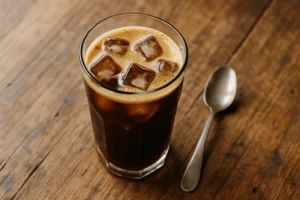
Iced Americano Recipe – Your Bold Guide to a Classic Cold Espresso Drink
RECIPE SHARE Some days, you want your coffee cold, black, and no-nonsense. No whipped cream, no syrup circus. Just something that hits sharp and fast,
The macchiato has its roots in early 20th-century Italy when espresso was gaining popularity. Baristas created it as a way to soften the intensity of espresso while preserving its bold flavor. By adding just a touch of milk, the macchiato became a balanced and enjoyable beverage for coffee lovers. The term “macchiato” translates from Italian as “stained” or “marked,” referring to the coffee being stained or marked with a dash of milk12. Italian coffee culture heavily influenced its evolution, and today, there are various iterations like caramel and coconut milk macchiatos.
1 – 2 Shots of Espresso
Steemed/ Frothed Milk
 Grind your espresso beans finely: Measure out about 18 grams of espresso beans and grind them finely. The grind should be similar to table salt.
Grind your espresso beans finely: Measure out about 18 grams of espresso beans and grind them finely. The grind should be similar to table salt.
Prepare your espresso shot: Heat up your espresso machine and portafilter. Once ready, dose the finely ground coffee into the portafilter. Use a tamper to evenly press the coffee grounds. Lock the portafilter into the machine and start the extraction process. Aim to extract 36 – 40 grams of espresso. The extraction time should be around 25-30 seconds.
Steam the milk: Traditional macchiatos only have a small amount of milk, just enough to “stain” the espresso. If you’re using milk, steam it using a milk steamer until it’s frothy and has a creamy texture. Be careful not to over-steam; you only need a small amount.
Add the “macchia”: The word “macchiato” means “stained” or “spotted” in Italian. To make a traditional macchiato, simply add a dollop (around 1-2 teaspoons) of frothed milk onto the surface of the espresso. This creates a contrast between the rich espresso and the creamy milk.
Serve and enjoy: Your traditional macchiato is now ready to be served! Enjoy it immediately to savor the rich espresso flavor with just a hint of creamy sweetness.

RECIPE SHARE Some days, you want your coffee cold, black, and no-nonsense. No whipped cream, no syrup circus. Just something that hits sharp and fast,

RECIPE SHARE Long Black Coffee – It’s All About The Order When I first began working at Starbucks, We had this regular that came every

RECIPE SHARE Cafe Cubano – Bold, Sweet, and Steeped in Tradition Café Cubano, also known as cafecito, is a small but mighty coffee drink that
We care a lot about the experience you have with coffee. A lot of work has gone into getting great beans to your door.
Get Updates From Us When We Create New Ways To Explore Coffee!